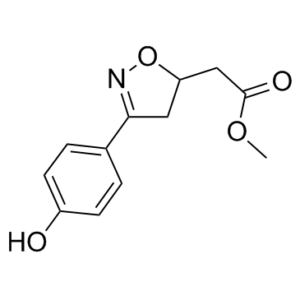ISO-1
This product is for research use only, not for human use. We do not sell to patients.

For small sizes, please check our retail website as below: www.invivochem.com
| Size | Price | Stock |
|---|---|---|
| 100mg | $450 | Check With Us |
| 500mg | $720 | Check With Us |
| 1g | $1080 | Check With Us |
Cat #: V9770 CAS #: 478336-92-4 Purity ≥ 98%
Description: ISO-1, formerly known as MIF Antagonist and ISO-1 and Macrophage Migration Inhibitory Factor, is a MIF inhibitor.
Top Publications Citing Invivochem Products
Publications Citing InvivoChem Products
Product Promise

- Physicochemical and Storage Information
- Protocol
- Related Biological Data
- Stock Solution Preparation
- Quality Control Documentation
| Molecular Weight (MW) | 501.55 |
|---|---|
| Molecular Formula | C24H27N3O7S |
| CAS No. | 478336-92-4 |
| SMILES Code | O=C(O)COC1=CC(N2CCN(S(=O)(C3=CC=C(OC(C)C)C=C3)=O)CC2)=CC=C1C4=NC=CO4 |
| Synonyms | S-555739; S 555739; S555739; Asapiprant |
| Protocol | In Vitro | Oral administration of Asapiprant to sheep at 1 and 3 mg/kg significantly (P<0.01) suppresses the increase in nasal resistance by 82% and 92%, respectively. Oral administration of Asapiprant to sheep at 5 mg/kg suppresses Prostaglandin (PG) D2 (PGD)2-induced nasal resistance by 86%. When orally administered 1 h before the antigen challenge in pigs, Asapiprant (3, 10, and 30 mg/kg) suppresses immediate airway response (IAR) by 52%, 57%, and 96%, and late airway response (LAR) by 67%, 50%, and 79%, respectively. Orally administered with Asapiprant (5 mg/kg) for 4 days, the Asapiprant significantly (P<0.01) suppresses antigen-induced nasal resistance by 73% in sheep. Treatment with 3 and 30 mg/kg of Asapiprant in pigs significantly (P<0.01) suppresses nasal secretion by 53% and 72%, respectively. Treatment with Asapiprant in rats at 10 mg/kg significantly (P<0.05) reduces airway hyper-responsiveness (AHR), infiltration of inflammatory cells, and mucin production in bronchoalveolar lavage fluid (BALF), although treatment with Asapiprant at 0.1 mg/kg does not have a significant effect on any responses. |
|---|
These protocols are for reference only. InvivoChem does not
independently validate these methods.
| Solvent volume to be added | Mass (the weight of a compound) | |||
|---|---|---|---|---|
| Mother liquor concentration | 1mg | 5mg | 10mg | 20mg |
| 1mM | 1.9938 mL | 9.9691 mL | 19.9382 mL | 39.8764 mL |
| 5mM | 0.3988 mL | 1.9938 mL | 3.9876 mL | 7.9753 mL |
| 10mM | 0.1994 mL | 0.9969 mL | 1.9938 mL | 3.9876 mL |
| 20mM | 0.0997 mL | 0.4985 mL | 0.9969 mL | 1.9938 mL |
The molarity calculator equation
Mass(g) = Concentration(mol/L) × Volume(L) × Molecular Weight(g/mol)
Mass
=
Concentration
×
Volume
×
Molecular Weight*
The dilution calculator equation
Concentration(start)
×
Volume(start)
=
Concentration(final)
×
Volume(final)
This equation is commonly abbreviated as: C1 V1 = C2 V2
Concentration(start)
C1
×
Volume(start)
V1
=
Concentration(final)
C2
×
Volume(final)
V2
Step One: Enter information below
Dosage mg/kg
Average weight of animals g
Dosing volume per animal µL
Number of animals
Step Two: Enter the in vivo formulation
%DMSO
+
%
+
%Tween 80
+
%ddH2O
Calculation Results:
Working concentration:
mg/ml;
Method for preparing DMSO master liquid:
mg
drug pre-dissolved in
µL
DMSO(Master liquid concentration
mg/mL)
,Please contact us first if the concentration exceeds the DMSO solubility of the batch of drug.
Method for preparing in vivo formulation:
Take
µL
DMSO master liquid, next add
µL
PEG300, mix and clarify, next add
µL
Tween 80,mix and clarify, next add
µL
ddH2O,mix and clarify.
Note:
- (1) Please be sure that the solution is clear before the addition of next solvent. Dissolution methods like vortex, ultrasound or warming and heat may be used to aid dissolving.
- (2) Be sure to add the solvent(s) in order.




































